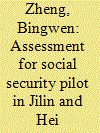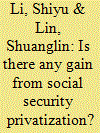| Srl | Item |
| 1 |
ID:
074185


|
|
|
|
|
| Publication |
2006.
|
| Summary/Abstract |
The present paper reviews the social security pilot in Jilin and Hei Longjiang that was carried out between 2004 and 2005. The pilot in the two provinces has basically achieved its main objectives, but there are still some unsolved problems, the most severe being lack of effective investment of the funds accumulated by individual accounts. During periods of high economic growth and high growth in average wages, this problem might undermine the partially-funded security system. To this end, the paper makes some suggestions, one of which is to introduce the notional defined contribution system.
|
|
|
|
|
|
|
|
|
|
|
|
|
|
|
|
| 2 |
ID:
106229


|
|
|
|
|
| Publication |
2011.
|
| Summary/Abstract |
Increasing calls for a social security reform of switching from the pay-as-you-go (PAYG) system to a funded system has been seen in recent decades. This paper examines the effect of this reform on capital accumulation and the welfare of each generation. Three methods are used to finance the pension debt, government debt financing, tax financing, and government asset financing. With government debt or tax financing, the market equilibrium remains unchanged and all generations are as well off in the new system as in the PAYG system. Thus, switching from the PAYG system to a funded system is neutral. With government asset financing, the interest rate will decrease, private capital will increase, but the total output may either increase or decrease. The welfare effect is also ambiguous in general, depending on the rate of return of government assets. With plausible parameters, our simulation shows that the reform will lower the interest rate, increase private capital, and lower government capital in the short run, but raise government capital and increase output in the long run.
|
|
|
|
|
|
|
|
|
|
|
|
|
|
|
|